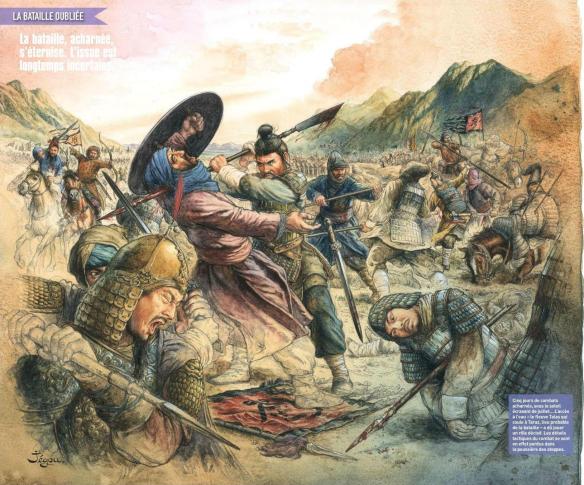Encounter with Arabs that checked Chinese advance. After the Han, most Chinese dynasties controlled points in Central Asia only to limited degrees because the costs of maintaining Chinese military forces so far from home were enormous. A noteworthy exception was the Tang Dynasty (618– 907), which, during its first half at least, could bring enormous resources to bear on the problem.
The Tang interest in central Asia had two roots. One was the desire to control Silk Route commerce, which, by Tang times, was enormously profitable. Second, the Tang needed to control advanced positions in central Asia to forestall potential enemies, above all the powerful Turkic tribes and states of the time that sought to control central Asian commerce for their own interests and to use the profits from it against China.
Thus Tang moved to control the Tarim Basin and points beyond almost from the beginning of its power, following up the lead of the previous dynasty, the Sui. As a result of these advances, Chinese influence extended to the Pamirs by the middle of the seventh century. China continued to maintain a dominant position in the area for the next 100 years, despite incursions by Turks, Tibetans, and others.
While the Tang were building and maintaining their central Asian empire, a new power had arisen in the west. Between 637 and 652, the Arabs conquered Sassanian Iran and Khorasan and, after a pause to assimilate their conquests, began a new advance into central Asia under Qutayba. This brought them directly into the Chinese sphere of influence, and a proxy war developed during the reign of Tang emperor Xuanzong (r. 713–755),with each side attempting to control its vassals and prevent the other from making any real inroads, although open warfare was avoided.
What finally broke this stalemate was the decision of the Tang government to restore its former position in the west to forestall the Tibetans, resulting in a series of expeditions by the Tang general Gao Xianzhi (750). Established in a new position of power by his conquests, Gao then overreached himself by executing the Turkic king of Tashkent. The king’s son called in Arabic troops from Sogdia. In late July 751, on the Talas River, Gao was crushed by the Arabs (although his army was not totally destroyed) after his Qarluqs auxiliaries had switched sides. Details are sketchy, even to the size of the armies (Arabic sources claim more than twice as many were killed or taken prisoner as were in the army of the Chinese general). Existing accounts are also from long after the event.
Some authorities have labeled the battle as decisive in determining that Islamic powers, not China, would control Turkistan. In fact, it was not the battle on the Talas River but the virtual collapse of the Tang dynasty during the An Lushan rebellion and its aftermath (755–763) that ended Tang influence in central Asia once and for all. The dynasty, Arabs or no, simply lacked the resources to assert itself again the way that it had under Xuanzong.
References and further reading: Barthold,W. Turkestan Down to the Mongol Invasion. 3d ed. Trans. T. Minorsky. Ed. C. E. Bosworth. London: Luzac and Company, 1968. Beckwith, Christopher I. The Tibetan Empire in Central Asia. Princeton, NJ: Princeton University Press, 1987. Grousset, Rene. The Empire of the Steppes: A History of Central Asia. Trans. Naomi Walford.New Brunswick, NJ: Rutgers University Press, 1970.
